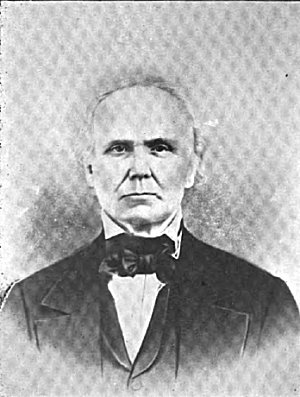
Mary Longely’s father served his country in the War of 1812; her grandfather, Col. Edmund Longley, served under George Washington in this nation’s War of Independence. Mary herself was a proud child of this nation’s first white settlers, “true and worthy representative of New England,” her husband, the Reverend Steven R. Riggs says in the first few pages of Mary and I: Forty Years with the Sioux, his record of their long service among the Dakota in Minnesota.
Neither ever said much at all about their love for each other, but then their Puritan ways likely forbade such silliness. In some ways, their marriage was arranged. Riggs was the son of an Ohio blacksmith, born with a far more ordinary working class, 19th century history than Mary Longely. His father pressed him into service in the shop, to work that obviously didn’t please him much; so he went off to apprentice at a harness maker—less smoke and soot, he suggests.

But Riggs says the Lord God appeared to him “in a wonderful manner” and altered the course of his life, “making discoveries of himself to my spiritual apprehension.” Riggs says very little more about this clear spiritual vision, but what happened wasn’t all that strange. Most of the nation was enlivened by similar visitations in what historians call “the Second Great Awakening.” To Riggs, God’s call was life-changing, “so from that time onward my path lie in the preparation for such service as He should call me into.”
Riggs became a Reverend, and it was in that capacity that he and Mary met and were married. Mary was a schoolmarm with enough adventuring spirit to head west; she accepted a teaching position in Bethlehem, Indiana, and immediately began to search for a means to get there.
 |
| Rev. Dyer Burgess |
Who cares about all of this missionary bingo? Here’s the point: Riggs characterizes his mentor and their cupid, the Reverend Dyer Burgess, as a “rabid abolitionist.” That he was, is of interest to our understanding Rev. Stephen and Mary Riggs and their place in the lives of the Dakota people and the Dakota War. They were--as Burgess was--abolitionists.
Just how “rabid” Mary Longely was about the cause of abolition—the end of slavery as an institution in America—is unclear. That her pastor husband was unalterably opposed to slavery is clear, however. Riggs claims Burgess hired him on as a ministerial understudy because, Riggs says, Burgess had perceived that Riggs was “of the same craft.” That characterization suggests strongly that Riggs too was a strong abolitionist, maybe even “rabid.”
All of this church genealogy is helpful because it's very simple today to create caricature and even villainy from 19th century missionaries to America's Indiginous, ever since Plymouth Rock, in fact. That Stephen and Mary Riggs were products of their time and place is indisputable. On their shoulders they carried heavily what was then called "the white man's burden." The colonialist arrogance that has, without a doubt, created no end of horrors all across this nation is evident in his memoirs: “. . .we were already in the land of the Dakotas, and passing by the teepees and the villages of the Red man, for whose enlightenment and elevation we had left friends and home.” Riggs is a creature of his time.
But when I say these Christian missionaries were both abolitionists, it's important to note how contrary that sentence feels. In secular society, a missionary is a bigot, but an abolitionist is a hero.
Well, mostly. The truth is, we still don’t know quite what to do with the most heralded of our “rabid” abolitionists, John Brown, a man so devoted to ending slavery that he led a suicidal revolt at Harpers Ferry, Virginia.
But less “rabid" abolitionists, those who charted and ran the underground railroad are, today, and deserve to be, American heroes, at least to those of us who live above Mason/Dixon. In fact, the Dyer Burgess house was just one stop on an Underground Railroad. He was, like the Riggs, an abolitionist.
 |
| The Dyer Burgess House, West Union, Ohio |
What’s more, one has to remember something of the times in which the Riggs worked. When, decades later, Richard Henry Pratt created the Carlyle Indian School with the express purpose of “assimilation through immersion,” his was the argument of white liberals, the progressives. The conservative alternative to "the Indian problem" was simple: extermination, genocide. As horrifying as that may sound, white missionaries, who undoubtedly did much to further colonization and its attendant horrors among Native America, were the enlightened alternative to mass murder.
I'm not making this up.
Not long ago, in my own denominational archives I found a note written by a highly respected early country preacher named Bode, who asserted that the denomination should never undertake mission activity among Native people because, he wrote, such savages simply could not be saved.
My denomination’s first missionary, Rev. Tomme Vanden Bosch, went to the Rosebud Reservation in the late 1880s, where he preached the gospel to Brule Sioux and, by his report, had little success, so little, in fact, that he left just two years later, convinced, as Bode was, that mission work among so foul a people was impossible.
In the next few days, I want to tell the story of Rev. Steven and Mary Riggs because we err in two distinct ways if we make 19th century missionaries like them into adoring saints on one hand, or vile colonialists on the other. The truth, as it always does, lies somewhere in the spacious ground between.
Were missionaries heroes? Yes and no.
Were missionaries villains? Yes and no.
That's the difficult and complex story I'd like to tell by way of the lives of Rev. Stephen and Mary Riggs.
No comments:
Post a Comment